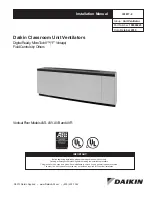
4
Twin City Engineering Supplement ES-895
Table 2. TSL Wheel-Funnel Overlap
SIZE
402
445
490
542
600
660
730
807
890
A
40.25
44.50
49.00
54.25
60.00
66.00
73.00
80.75
89.00
B
1.03
1.13
1.25
1.38
1.56
1.69
1.88
2.09
2.28
C (CL 1)
16.23
17.92
19.64
21.70
24.08
26.42
29.19
32.30
35.66
C (CL 2)
16.23
17.92
19.64
21.70
24.08
26.42
29.19
32.30
35.66
C (CL 3)
16.30
17.98
19.70
21.83
24.14
26.48
29.25
32.36
35.70
SIZE
122
150
182
200
222
245
270
300
330
365
A
12.25
15.00
18.25
20.00
22.25
24.50
27.00
30.00
33.00
36.50
B
0.31
0.38
0.56
0.63
0.69
0.75
0.88
0.97
1.06
0.94
C (CL 1)
4.69
5.86
7.36
8.00
8.89
9.86
10.91
11.89
13.31
14.72
C (CL 2)
4.72
5.86
7.42
8.06
8.95
9.86
10.91
11.89
13.31
14.72
C (CL 3)
—
—
7.48
8.13
9.08
9.92
10.97
12.14
13.38
14.78
C
B
A
Note: Use “B” dimension for positioning wheel.
Table 3. QSL Wheel-Funnel Overlap
B
A
C
Note: Use “B” dimension for positioning wheel.
SIZE
150
165
182
200
222
245
270
300
330
A
18.25
20.00
22.25
24.50
27.00
30.00
33.00
36.50
40.25
B
0.56
0.63
0.69
0.75
0.88
0.97
1.06
0.94
1.03
C
6.19
6.75
7.56
8.31
9.13
10.19
11.19
12.38
13.63
SIZE
365
402
445
490
542
600
660
730
A
44.50
49.00
54.25
60.00
66.00
73.00
80.75
89.00
B
1.13
1.25
1.38
1.56
1.69
1.88
2.09
2.28
C
15.13
16.63
18.38
20.25
22.31
24.63
27.25
30.00
motor plate should be as parallel as possible to the fan
centerplane. Care should be taken to maintain drive
alignment and proper belt tension.
Bearing Maintenance
Proper lubrication of the fan drive bearings helps assure
maximum bearing life. All fans are equipped with decals
indicating relubrication intervals for normal operating
conditions. See Figures 2, 3 and 4 for typical lubrication
data. However, every installation is different and the
frequency of relubrication should be adjusted accordingly.
On high moisture applications, the lubrication
frequency may need to be doubled or tripled to
adequately protect the bearings. Double the relubrication
frequency on fans with vertical shafts.
Observation of the conditions of the grease expelled
from the bearings at the time of relubrication is the best
guide as to whether regreasing intervals and amount of
grease added should be altered.
Greases are made with different bases. There are
synthetic base greases, lithium base, sodium base, etc.
Avoid mixing greases with different bases. They could
be incompatible and result in rapid deterioration or
breakdown of the grease. The lubrication sticker
identifies a list of acceptable lubricants. All bearings are
filled with a lithium-based grease before leaving the
factory. When the fans are started, the bearings may
discharge excess grease through the seals for a short
period of time. Do not replace the initial discharge
because leakage will cease when the excess grease has
worked out. Sometimes the bearings have a tendency to
run hotter during this period. There is no reason for alarm
unless it lasts over 48 hours or gets very hot (over
200°F). When relubricating, use a sufficient amount of
grease to purge the seals. Rotate bearings by hand
during relubrication.
Wheel and Shaft Maintenance
Periodically inspect the shaft and wheel for dirt buildup,
corrosion, and signs of excess stress or fatigue. Clean
the components. If the wheel is removed for any reason,
make sure that it is securely attached to the shaft before
restarting the fan.
Structural Maintenance
All structural components or devices used to support or
attach the fan to a structure should be checked at
regular intervals. Vibration isolators, bolts, foundations,
etc., are all subject to failure from corrosion, erosion,
and other causes. Improper mounting can lead to poor
operation characteristics or fan fatigue and failure. Check
metallic components for corrosion, cracks, or other signs
of stress. Concrete should be checked to insure the
structural integrity of the foundation.


























